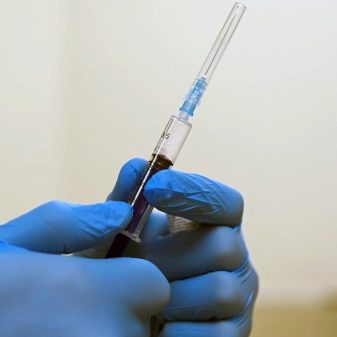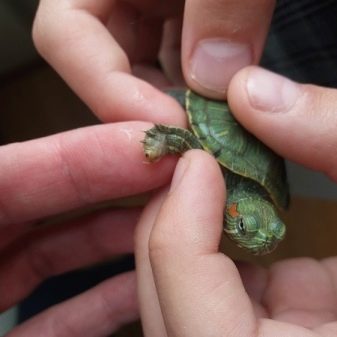Pond slider

The red-eared turtle is one of the most popular species of domestic reptiles. However, as practice shows, many reptiles die due to being kept in inappropriate conditions. To prevent this from happening, we will tell you in detail about the habits of this creature, as well as the rules of keeping, feeding and caring for it.
Description
Red-eared turtles belong to the family of freshwater American turtles. They look very amusing - they have red (yellow in some subspecies) spots near their eyes. In the West, red-eared turtles are sometimes called "sliders" for their innate ability to slide off the shore into a body of water at lightning speed at the time of a dangerous situation.
A turtle that is not used to its new owner should be handled with extreme care, avoiding sudden movements. The bite of this reptile can be very painful. In addition, in a stressful situation, turtles begin to make loud sounds: hiss and snort. These animals see well, they have an excellent sense of smell, but their hearing is slightly less developed. They breathe both in water and on land.

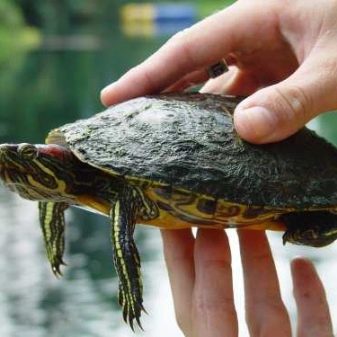
When choosing a pet, you need to focus on its appearance. An inactive turtle huddled in a corner with closed eyes should certainly alert you - most likely, it is unhealthy. The carapace should be tight, with no signs of chips, build-ups, or scratches. Claws should be present on all limbs, the presence of light spots on the head is possible. While in the water, the reptile must move quickly, not toppling to one side when swimming.
Most of the body of the red-eared turtle is occupied by a hard shell, it consists of multiple keratinized plates. The head is small, four limbs peek out from under the shell, as well as a small tail in the shape of a triangle. At the moment of fright, the reptile quickly retracts its head and folds its limbs so that the attacker would not be able to grab it by the soft areas. Elastic membranes are provided between the toes, so that the reptiles move in the water.
An adult turtle grows up to 25-35 cm, the exact dimensions depend on its age, as well as gender and variety. Females are much larger than males. The growth rate differs at different stages of an animal's life: at a young age, reptiles add 8-10 cm every year, adult pets grow no more than 1-2 cm per year until they reach their maximum length. In juvenile red-eared reptiles, the shell has a rich green color. As it grows older, it turns brown, sometimes it turns dark olive.
Red-eared turtles are often referred to as centenarians. When creating optimal conditions of detention, their life span is 20-25 years. Some even live up to 40 years.
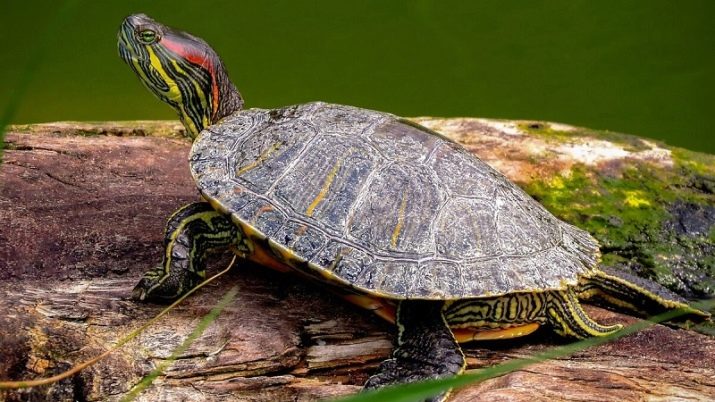
Subspecies
Zoologists distinguish 3 main types of red-eared turtles:
- Trachemys scripta elegans - the "red-eared slider" itself, also known as the American, or Florida, turtle;
- Trachemys scripta scripta - nominative subspecies, yellow-bellied slider;
- Trachemys scripta troostii - among lovers of reptiles, it is referred to as the Cumberland tortoise, aka the Truste tortoise.


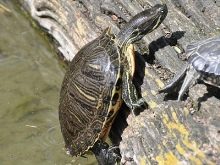
Habitat
In the wild, the red-eared reptile's habitat ranges from the American South to the northern regions of Colombia and Venezuela. Reptiles are found in shallow lakes, rivers and shallow ponds. These creatures lead an inactive lifestyle - either slowly looking for prey, slowly moving through their reservoir, or, having satisfied their hunger, crawl ashore and bask in the warm rays of the sun.
The increased endurance of these animals has led to the fact that it became possible to breed them not only at home, but also in European countries, as well as in the southeastern territories of Asia, in Japan, Korea, China and South Africa. And here in Australia, red-eared turtles are officially considered pests, as they compete with the local water and land turtles and are rapidly displacing them from their usual habitats.
Unfortunately, in Russia, red-eared turtles can often be found in city ponds - many of them were thrown there by unscrupulous owners.

Home care
Long life and health of a reptile are possible only when creating and maintaining the most favorable conditions for it.
Aquarium and filter
You should start with the selection of a suitable terrarium. Taking into account the size of adult turtles, the comfort volume is approximately 100-150 liters per bird. In this case, the bottom area should be maximum, the height may be insignificant. The back wall of the tank is usually made slightly higher than the front one - this is important for ease of observation and placement of aquarium equipment. The minimum permissible level of filling with water should be such that the reptile can easily stick its head out of the water, if necessary, standing on its hind legs for this.
In the aquarium, you need to provide a land area with a bridge so that reptiles can crawl out of the water along it. Its volume should occupy about 1⁄4 of the entire dwelling. It should be borne in mind that reptiles in the course of their vital activity quite heavily pollute the aquaterrarium, therefore a number of measures must be taken to maintain the purity of the water. First of all, you need to equip a reliable filtration. For this, powerful filters are installed - external or internal. In addition, every week you need to change up to 25% of the water to clean, fresh.
Important. When preparing water, it is advisable to use a conditioner. It removes all chlorine and harmful salts of heavy metals, and also enriches the water with vitamins and natural colloids.In parallel with the renewal of the water, the soil is cleaned.
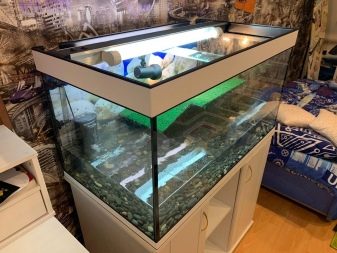
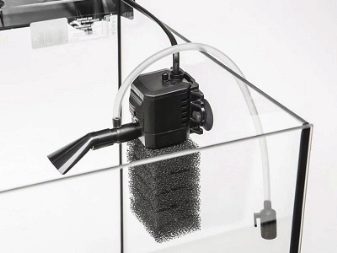
Lighting
Above the land bridges, where the turtle will rest, two lamps should be fixed. The first one is needed for heating: you can take the simplest incandescent lamp or a specialized one for amphibians. The second lamp should be ultraviolet. UV radiation is very important for red-eared pets, because without it, animals cannot synthesize vitamin D, which is important for the full assimilation of calcium. Prolonged exposure to a lack of ultraviolet radiation leads to the appearance of rickets in turtles and softening of the shell tissues.
Experts recommend taking light bulbs with 5% or 10% rays of the UV spectrum. At the same time, it is important that they are fixed outside the pet's access zone so that the reptile does not break them and get burned. Both lamps should be turned off at night. In the summer months, it is allowed to take out red-eared turtles to the fresh air, the most important thing is not to leave them in direct sunlight. The duration of sunbathing should increase progressively, from 5 minutes per day. Such walks have a beneficial effect on the health of reptiles.
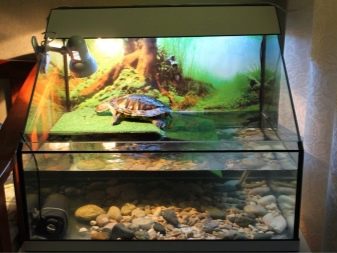
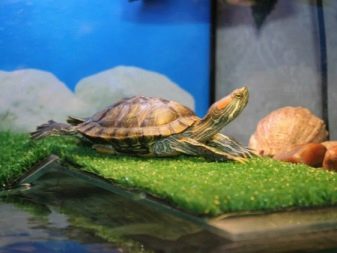
Soil and algae
The soil in the aquaterrarium can not be used at all, like any other decor - red-eared turtles do not need it. But if you do not want the aquaterrarium to look dull, then you can put several large stones on the bottom. If you use small ones, then reptiles can accidentally swallow them and die.
In addition, taking care of the terrarium in this case will be more troublesome. It is advisable to take stones, the size of which exceeds the size of the animal's head. Additionally, it is worth decorating the "home" with artificial algae - the living ones will very soon be destroyed by the turtles.
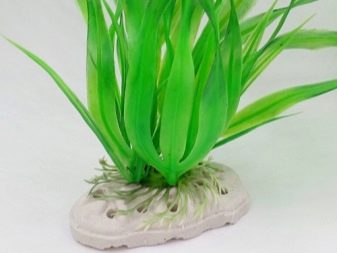
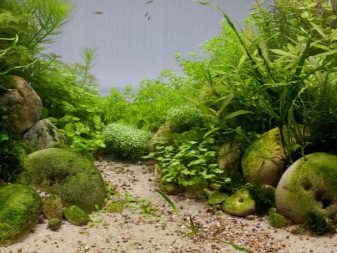
Water temperature
Turtles, like all reptiles, are cold-blooded creatures. This means that their blood temperature is directly dependent on environmental conditions. If the liquid is too cold, then the animal will become inactive, lethargic, the metabolism will gradually slow down and the work of the digestive organs will stop. Prolonged stay in such a state can cause the death of a pet, therefore it is extremely important to maintain a comfortable temperature background.
The water temperature in the aquarium should be 27-28 degrees, it is better to install a heater on land to maintain the temperature at 30-33 degrees. In stores, you can buy thermostats, they allow you to automatically maintain the necessary heating of the water, they need to be fixed in a place inaccessible to turtles.
But such characteristics as water hardness and acidity level do not play a special role in caring for reptiles.
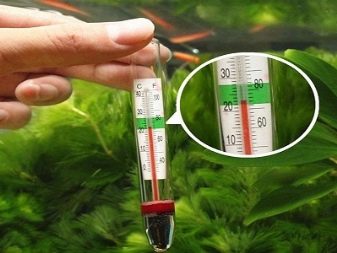
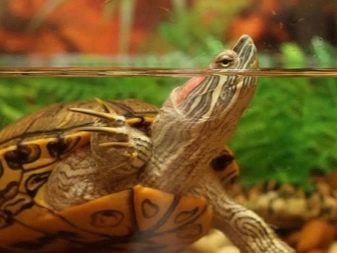
Feeding
Red-eared turtles are predators by nature, therefore their food ration should consist of 75% of animal components and only 25% of plant components. It is desirable to take high quality dry food as the main product for these animals. It is distinguished by a balanced content of food components, the presence of proteins, as well as calcium and phosphorus for the proper growth of the animal and hard shell. Additionally, the reptiles can be fed with chopped pieces of white sea fish. With great pleasure the turtles eat the "sea cocktail" of pieces of squid, chopped shrimp and octopus. It is unlikely that pets will refuse snails, from time to time they should be offered live or preserved insects.
The sources of plant components are aquatic vegetation - duckweed, as well as Riccia or hornwort. You can give the reptiles scalded with boiling water and chopped lettuce or dandelion leaves. It is very useful to add pumpkin, apples, tomatoes and fresh cucumbers to the feeder. For full growth and development, domestic turtles, especially young ones, need calcium - it goes into the formation and strengthening of bone and shell tissue.Be sure to use specialized calcium blocks or mineral supplements. Introduce vitamin concentrates into the diet every 7-10 days. The use of vitamins helps to strengthen the immune system and normalize vital processes.
Young reptiles need daily feeding, adults can be offered food no more than once every 2-3 days, otherwise they can be overfed... Feeding can be done either in the aquaterrarium or in a separate container to reduce contamination of the terrarium. Red-eared turtles very quickly get used to their owners and often allow people to feed themselves from their hands.
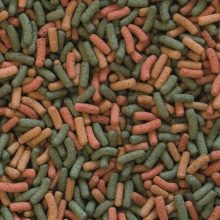
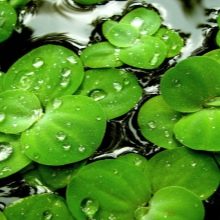

Compatibility
The best option for keeping domestic reptiles is a specialized species aquaterrarium. Despite the fact that the options for the joint habitation of turtles and simple aquarium fish are known, this is often an exception to the rule. Of course, small reptiles cannot yet swallow their larger neighbors, therefore they will calmly get along, for example, with cichlids. But the growth rate of these reptiles is quite high, and the hunter's instinct is highly developed. As practice shows, in the overwhelming majority of cases, coexistence will result in bitten fins, and then the destruction of fish by reptiles.
Any small fish, such as neons, guppies, as well as tetras or barbs, will be considered by red-eared turtles exclusively as food. Do not add domestic amphibians to reptiles - axolotls, newts or frogs. It is unlikely that such cohabitation will end with something good for amphibians. But you can release several red-eared turtles into one aquaterrarium. However, in this case, the volume of the "house" should be sufficient for a comfortable stay of all individuals.
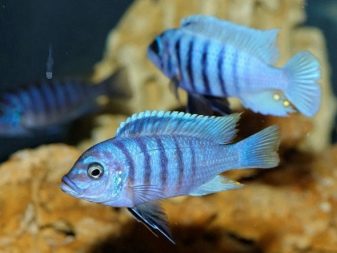
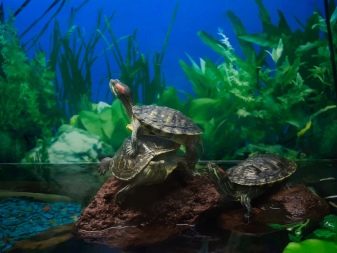
Hibernation
Breeders of red-eared turtles should understand that there is no need for hibernation in domestic reptiles. Moreover, it may not be safe for the pet. There are several reasons for this:
- you may lack the knowledge to organize proper care for reptiles during this period;
- there are simply no conditions in the apartments to maintain the healthy hibernation of the pet;
- young and sick turtles are greatly weakened, it is difficult for them to endure the state of hibernation;
- and finally, a domestic reptile may not require winter suspended animation at all.
In the wild, hibernating, turtles burrow into leaves or silt at the bottom of the reservoir. While animals hibernate, they do not swim to the surface, but at the same time they fully assimilate the oxygen they need through special membranes of the oral cavity, in the pharynx, and also in the cloaca. In this case, the depth of the reservoir plays a significant role - it should be such that the water is not too cool, but also contains a large amount of oxygen. The overwhelming majority of artificial reservoirs cannot recreate such conditions.
Thus, the domestic reptile does not need to be hibernated. The main factor here is the water temperature, it should be kept at the level of 23-25 degrees. A colder environment will just remind the animal of coldness and hibernation.
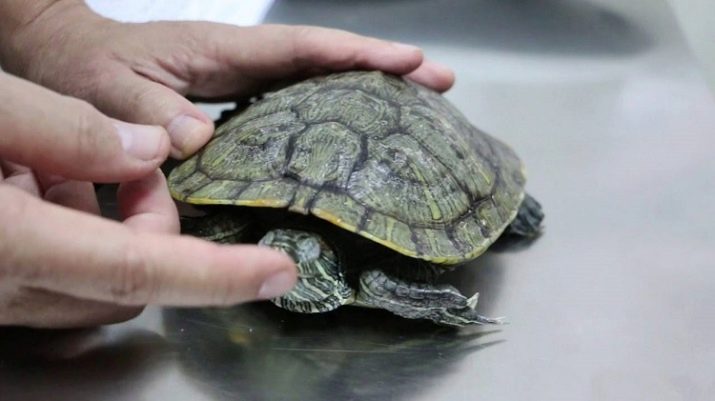
Reproduction
Breeding red-eared turtles in the house is a rather laborious and troublesome process that requires certain skills and specialized equipment. For reproduction, it is advisable to take individuals at the age of 4-6 years. To create a pair, a small group of turtles is placed in one terrarium, while it is optimal that there are two females for each male. To distinguish pets by sex, you should carefully examine their claws and tail - in males they are slightly longer, as well as a shell - in males, a slight depression is noticeable, in females, on the contrary, you can feel a bulge. When the animals are preparing for mating, they arrange mating games - fights, in this way the males attract the attention of the females. If you realize that a pair has formed, it should be placed in a separate house.Reproduction can be stimulated by maintaining the temperature at a level not lower than 26 degrees, as well as a gradual increase in the duration of daylight hours and illumination parameters.
The females of the reptile do not give birth, but lay their eggs in wet sand, therefore, a container with sand or peat must be foreseen in advance in the terrarium, with a layer of at least 5-6 cm. If it is not there, then the females will begin to lay eggs directly on land, and sometimes in water. The number of eggs in a clutch, as a rule, is 7-10 pcs. At the same time, the animals do not show any concern for their offspring, the females simply leave the laid clutch. The eggs are placed in an incubator, where a stable temperature is maintained at 28-30 degrees. An interesting fact: if you keep the eggs at a temperature less than 27 degrees, then only males will hatch from the eggs, if the thermometer rises above 30 degrees, then females. The incubation process usually takes 3 to 5 months, then the young reptiles break the shells and quickly get out. At this point, you can see the remainder of the yolk sac in them, usually it dissolves in a few days. Newborn turtles are kept in an insulated container as they can be seriously injured by adults.
Turtles reach sexual maturity at the age of one year, therefore, it is possible to reliably determine the sex of a pet only after it reaches a size of 10 cm or more. As a rule, a male can be more or less accurately identified at 2-3 years old, females at 3-5 years old.

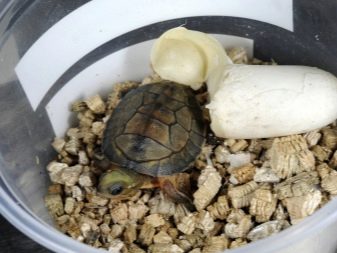
Possible diseases
Over 80% of all pathologies of red-eared reptiles are the result of illiterate care, housing conditions and feeding rules. Here are the rules for keeping your turtle healthy. Sick turtles should be kept at elevated temperatures - 28-30 degrees. Under these conditions, immunity functions at its peak. You should also maintain an optimal fluid balance in the reptile's body to prevent dehydration. Keeping the turtle sawed and in the water is much more important than feeding it, as the kidneys fail and dies when the turtle is dehydrated.
A sick reptile swims with difficulty, usually on one side; in case of a severe illness, it can even drown. In this situation, you need to lower the water level and make sure that the turtle can crawl out onto land whenever it wants. If pathology is suspected, isolate the pet immediately. Be sure to clean your hands after any interaction with him. The basis for the effectiveness of therapy for a turtle is a timely visit to the veterinarian. If the turtle does not grow, it stretches its neck, opens its mouth, flakes, peels off, it develops swelling and swelling, it is necessary to consult a specialist immediately.
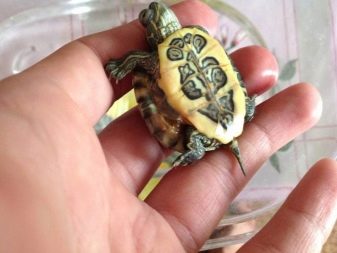
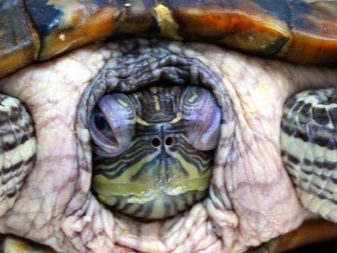
Consider what ailments turtles most often encounter.
- The eyes of the animal are swollen and reddened, this can be accompanied by secretions - most likely, the pet has a bacterial eye infection, caused by contaminated water. Treatment involves the use of antibiotic drops and cleaning the terrarium.
- Formations of a necrotic nature appear in the mouth. The pet refuses food, eyes are covered - these are symptoms of an infection caused by gram-negative bacteria. The disease requires the most serious treatment, including the use of antibiotics and the treatment of the mouth and teeth with antimicrobial solutions.
- The animal is lethargic, raises its head high, can often show weakness in the limbs, wheezing and nasal discharge are observed - this is a respiratory disease, possibly pneumonia. In such a situation, antibiotic injections are prescribed.
- The shell softens, it can be accompanied by an unpleasant pungent odor - this is a bacterial tissue pathology due to burns or damage from sharp corners and stones.This animal requires isolation, removal of all dead tissue and treatment of lesions with antimicrobial drugs.
- Weakness, constant lethargy and redness of the plastron are signs of blood poisoning. Usually, sepsis develops when pathogenic bacteria from contaminated water enter the bloodstream.
The situation can be saved by starting a course of antibiotics immediately after the first signs of the disease appear.
